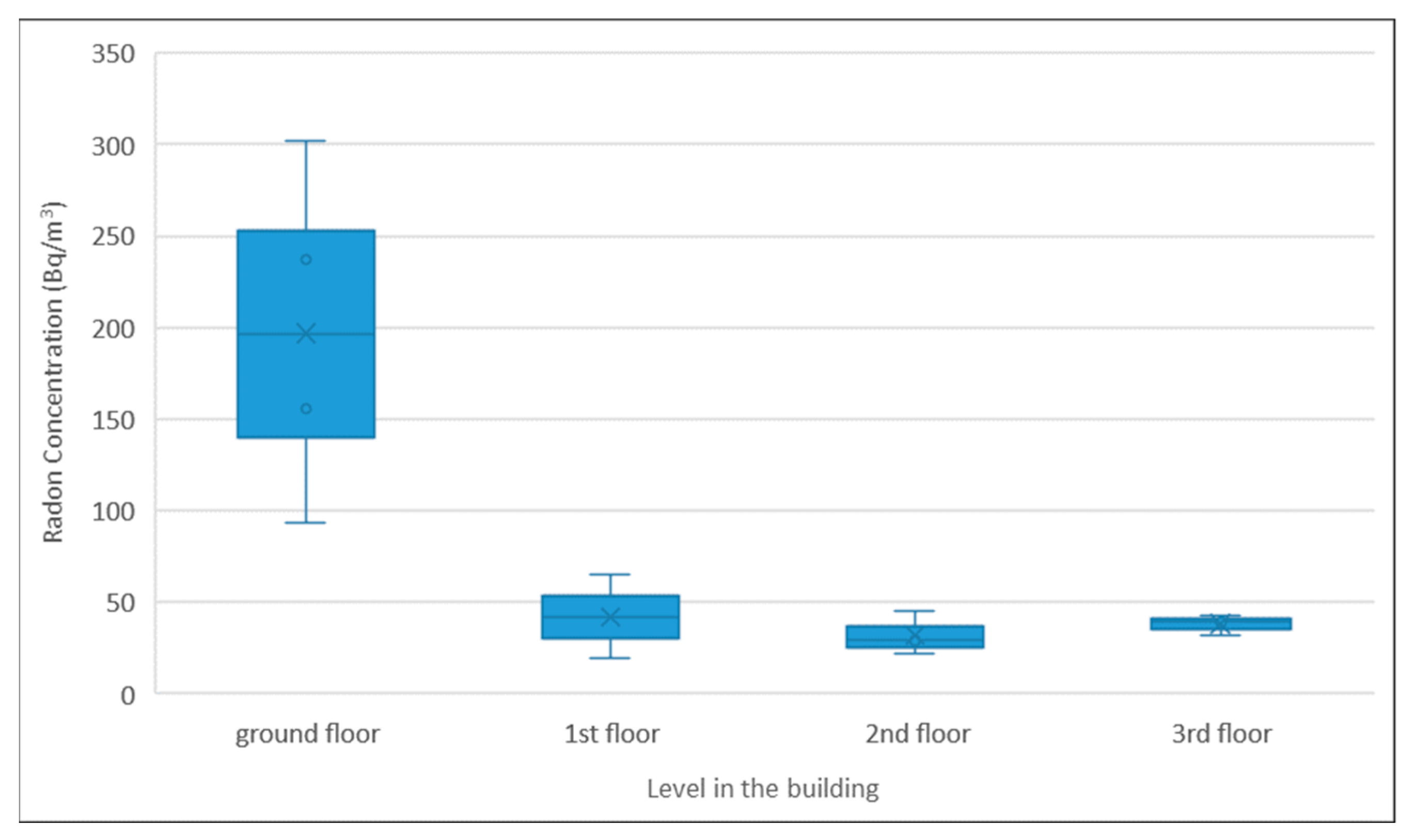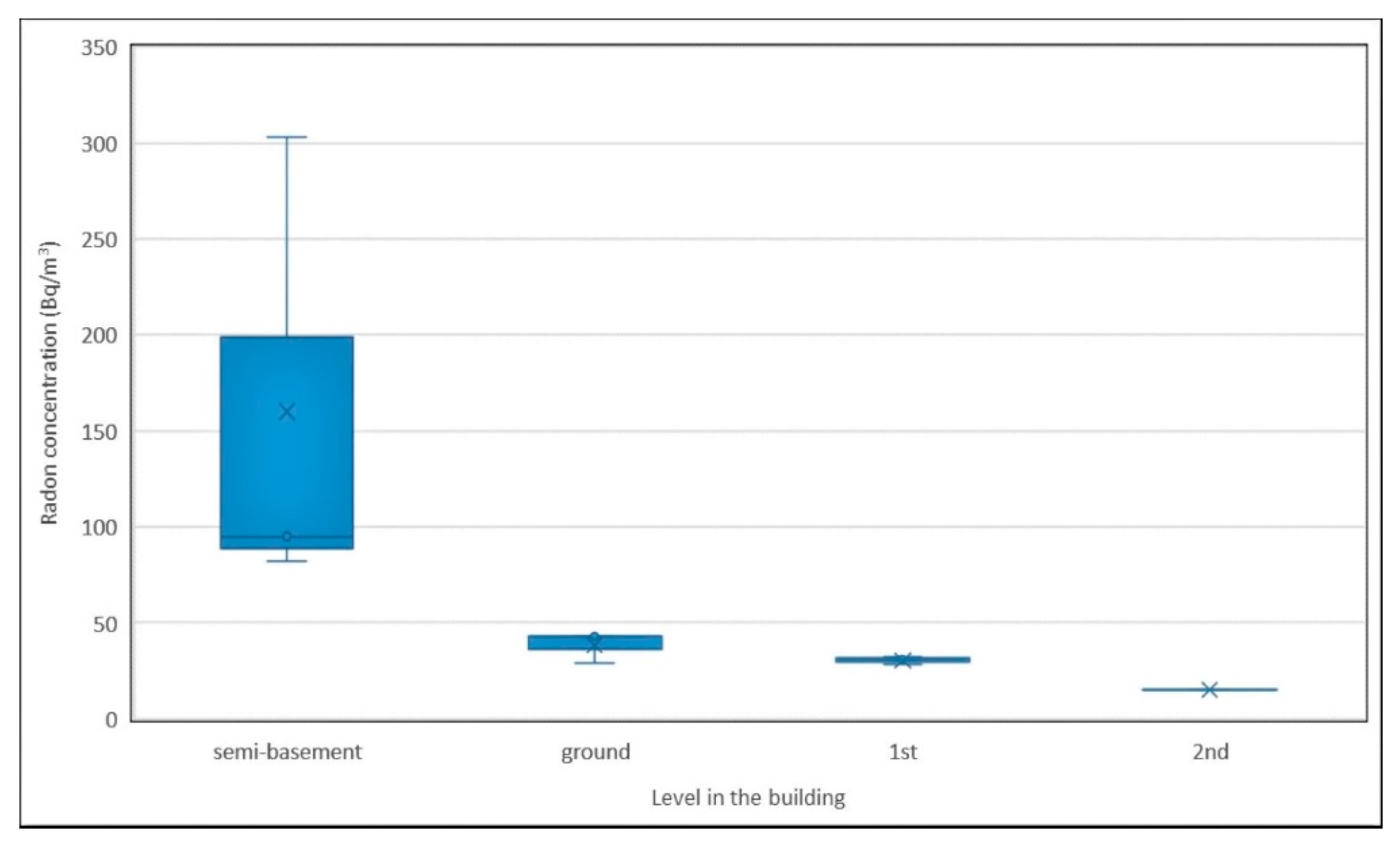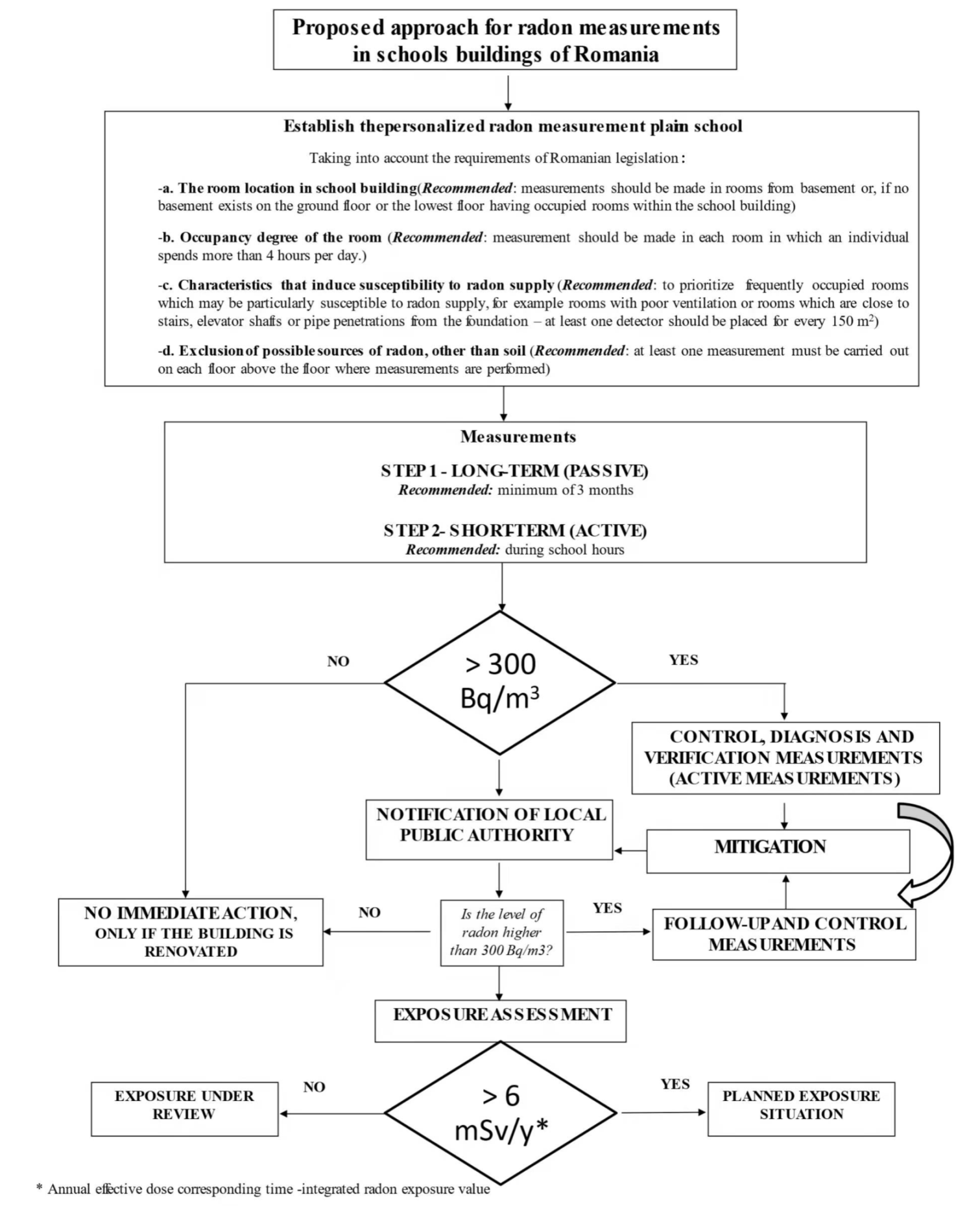First Steps towards a National Approach for Radon Survey in Romanian Schools
Abstract
1. Introduction
2. Materials and Methods
2.1. Measurement Technique
2.2. Radon Surveys in Romanian Schools
2.3. Pilot Study
3. Results and Discussion
3.1. Overall Results—Radon Survey in Romanian Schools
3.2. Results of Pilot Study
3.3. Proposal for an Approach for Radon Measurements in Schools
4. Conclusions
Author Contributions
Funding
Acknowledgments
Conflicts of Interest
References
- Government Decision 526/25.07.2018 for the Approval of the National Radon Action Plan. 2018. Available online: http://www.cncan.ro/assets/Uploads/HG-25072018-PNAR.pdf (accessed on 30 August 2018).
- European Union. Council Directive 2013/59/EURATOM of 5 December 2013 laying down basic safety standards for protection against the dangers arising from exposure to ionising radiation, and repealing Directives 89/618/Euratom, 90/641/Euratom, 96/29/Euratom, 97/43/Euratom and 2003/122/Euratom. Off. J. Eur. Union 2014, 13, 1–73. [Google Scholar]
- Cosma, C.; Cucoş, A.; Dicu, T. Preliminary results regarding the first map of residential radon in some regions in Romania. Radiat. Prot. Dosim. 2013, 155, 343–350. [Google Scholar] [CrossRef] [PubMed]
- Cucoş, A.; Cosma, C.; Dicu, T.; Begy, R.; Moldovan, M.; Papp, B.; Nita, D.; Burghele, B.; Sainz, C. Thorough investigations on indoor radon in Baita radon-prone area (Romania). Sci. Total Environ. 2012, 431, 78–83. [Google Scholar] [CrossRef]
- Cinelli, G.; Tollefsen, T.; Bossew, P.; Gruber, V.; Bogucarskis, K.; De Felice, L.; De Cort, M. Digital version of the European Atlas of natural radiation. J. Environ. Radioact. 2019, 196, 240–252. [Google Scholar] [CrossRef]
- Lecomte, J.-F.; Solomon, S.; Takala, J.; Jung, T.; Strand, P.; Murith, C.; Kiselev, S.; Zhuo, W.; Shannoun, F.; Janssens, A. Radiological Protection against Radon Exposure. Ann. ICRP 2014, 43, 5–73. [Google Scholar] [CrossRef]
- WHO. WHO Handbook on Indoor Radon—A Public Health Perspective; World Health Organization: Geneva, Switzerland, 2009; p. 110. [Google Scholar]
- Brenner, D.J. ICRP Protection against radon-222 at home and work. Ann. ICRP 1992, 23, 1–38. [Google Scholar]
- Van Dijken, F.; van Bronswijk, J.-E.; Sundell, J. Indoor environment and pupils’health in primary schools. Build. Res. Inf. 2006, 34, 437–446. [Google Scholar] [CrossRef]
- Ozasa, K.; Shimizu, Y.; Suyama, A.; Kasagi, F.; Soda, M.; Grant, E.J.; Sakata, R.; Sugiyama, H.; Kodama, K. Studies of the mortality of atomic bomb survivors, Report 14, 1950–2003: An overview of cancer and noncancer diseases. Radiat. Res. 2012, 177, 229–243. [Google Scholar] [CrossRef]
- Stojanovska, Z.; Zunic, Z.; Bossew, P.; Bochicchio, F.; Carpentieri, C.; Venoso, G.; Mishra, R.R.; Rout, R.-P.; Sapra, B.-K.; Burghele, B.-D.; et al. Results from time integrated measurements of indoor radon, thoron and their decay product concentration in schools in the Republic of Macedonia. Radiat. Prot. Dosim. 2014, 162, 152–156. [Google Scholar] [CrossRef]
- Azara, A.; Dettori, M.; Castiglia, P.; Piana, A.; Durando, P.; Parodi, V.; Salis, G.; Saderi, L.; Sotgiu, G. Indoor Radon Exposure in Italian Schools. Int. J. Environ. Res. Public Health 2018, 15, 749. [Google Scholar] [CrossRef]
- Vaupotic, J.; Bezek, M.; Kávási, N.; Ishikawa, T.; Yonehara, H.; Tokonami, S. Radon and thoron doses in kindergartens and elementary schools. Radiat. Prot. Dosim. 2012, 152, 247–252. [Google Scholar] [CrossRef]
- Zunic, Z.-S.; Carpentieri, C.; Stojanovska, Z.; Antignani, S.; Veselinovic, N.; Tollefsen, T.; Carelli, V.; Cordedda, C.; Cuknic, O.; Filipovic, J.; et al. Some results of a radon survey in 207 Serbian schools. Rom. J. Phys. 2013, 58, 320–327. [Google Scholar]
- Geranios, A.; Kakoulidou, M.; Mavroidi, P.; Moschou, M.; Fischer, S.; Burian, I.; Holecek, J. Radon survey in Kalamata (Greece). Radiat. Prot. Dosim. 2001, 93, 75–79. [Google Scholar] [CrossRef] [PubMed][Green Version]
- Papaefthymiou, H.; Georgiou, C.-D. Indoor radon level in primary schools of Patras, Greece. Radiat. Prot. Dosim. 2007, 124, 172–176. [Google Scholar] [CrossRef]
- Clouvas, A.; Xanthos, S.; Takoudis, G. Indoor radon levels in Greek schools. J. Environ. Radioact. 2011, 102, 881–885. [Google Scholar] [CrossRef] [PubMed]
- Synnott, H.; Hanley, O.; Fenton, D.; Colgan, P.-A. Radon in Irish schools: The results of a national survey. J. Radiol. Prot. 2006, 26, 85–96. [Google Scholar] [CrossRef] [PubMed]
- EPA. Radon Measurements in Schools. Revised Edition. 1993; p. 44. Available online: https://nepis.epa.gov/Exe/ZyPDF.cgi/910188F5.PDF?Dockey=910188F5.PDF. (accessed on 12 September 2021).
- Health Canada. Guide for Radon Measurements in Public Buildings (Workplaces, Schools, Day Cares, Hospitals, Care Facilities, Correctional Centres). 2016, p. 22. Available online: https://www.canada.ca/en/health-canada/services/environmental-workplace-health/reports-publications/radiation/guide-radon-measurements-public-buildings-schools-hospitals-care-facilities-detention-centres.html/ (accessed on 3 September 2021).
- Norwegian Radiation Protection Authority. Protocol for Radon Measurements in Schools and Kindergartens. 2015, p. 23. Available online: https://www.nrpa.no/publikasjon/protocol-for-radon-measurements-in-schools-and-kindergartens.pdf (accessed on 28 August 2021).
- Bochicchio, F.; Žunić, Z.-S.; Carpentieril, C.; Antignani, S.; Venoso, G.; Carelli, V.; Cordedda, C.; Veselinović, N.; Tollefsen, T.; Bossew, P. Radon in indoor air of primary schools: A systematic survey to evaluate factors affecting radon concentration levels and their variability. Indoor Air 2014, 24, 315–326. [Google Scholar] [CrossRef] [PubMed]
- Cucoș, A.; Papp, B.; Dicu, T.; Moldovan, M.; Burghele, B.-D.; Moraru, I.; Tenter, A.; Cosma, C. Residential, soil and water radon surveys in north-western part of Romania. J. Environ. Radioact. 2017, 166, 412–416. [Google Scholar] [CrossRef] [PubMed]
- Cosma, C.; Papp, B.; Cucoş, A.; Sainz, C. Testing radon mitigation techniques in a pilot house from Băiţa-Ştei radon prone area (Romania). J. Environ. Radioact. 2015, 140, 141–147. [Google Scholar] [CrossRef]
- Cucoş, A.; Dicu, T.; Cosma, C. Indoor radon exposure in energy-efficient houses from Romania. Rom. J. Phys. 2015, 60, 1574–1580. [Google Scholar]
- Muntean, L.E.; Cosma, C.; Cucos, A.; Dicu, T.; Moldovan, D.-V. Assessment of annual and seasonal variation of indoor radon levels in dwelling houses from Alba County, Romania. Rom. J. Phys. 2014, 59, 163–171. [Google Scholar]
- Burghele, B.D.; Cosma, C. Thoron and radon measurements in Romanian schools. Radiat. Prot. Dosim. 2012, 152, 38–41. [Google Scholar] [CrossRef] [PubMed]
- Istrate, A.-M.; Catalina, T.; Cucoș, A.; Dicu, T. Experimental measurements of VOC and Radon in two Romanian classrooms. Energy Procedia 2016, 85, 288–294. [Google Scholar] [CrossRef][Green Version]
- Cosma, C.; Ciorba, D.; Timar, A.; Szacsvai, K.; Dinu, A. Radon exposure and lung cancer risk in Romania. J. Environ. Prot. Ecol. 2009, 10, 94–103. [Google Scholar]
- Romania. Law 63/2018. In Official Law Bulletin; Part I no. 225 of 13 March 2018. 2018. (In Romanian)
- Order of Ministery of Health 752/3.978/136. In Official Law Bulletin; Part I no. 517 of 25 June 2018. 2018. (In Romanian)
- Order of the CNCAN President No. 185/2019 for the Approval of the Methodology for Determining the Radon Concentration in the Air Inside Buildings and at Workplaces. In Official Law Bulletin; Part I no. 655 of 7 August 2019.
- Miles, J.-C.-H.; Howarth, C.-B.; Hunter, N. Seasonal variation of radon concentrations in UK homes. J. Radiol. Prot. 2012, 32, 275–287. [Google Scholar] [CrossRef] [PubMed]
- IAEA Report 98. Design and Conduct of Indoor Radon Survey. Available online: https://pub.iaea.org/MTCD/Publications/PDF/IAEA-AQ-33_web.pdf (accessed on 9 December 2021).
- European Commission. Implementing the Requirements in Council Directive 2013/59/Euratom; Radiation Protection No. 193; European Commission: Brussels, Belgium, 2020. [Google Scholar]



| County | N | AM (Bq/m3) | SD (Bq/m3) | Min (Bq/m3) | Max (Bq/m3) | Median (Bq/m3) | GM (Bq/m3) |
|---|---|---|---|---|---|---|---|
| Alba | 20 | 262 | 277 | 86 | 1121 | 360 | 313 |
| Bacau | 15 | 119 | 62 | 29 | 237 | 116 | 103 |
| Cluj | 34 | 141 | 124 | 23 | 460 | 97 | 99 |
| Satu-Mare | 15 | 127 | 19 | 85 | 167 | 125 | 125 |
| Sibiu | 25 | 68 | 35 | 27 | 174 | 69 | 60 |
| Building | Room Usage | Floor | CRn (Bq/m3) | Uncertainty |
|---|---|---|---|---|
| D | secretariat | ground | 237 | 8 |
| D | classroom | ground | 302 | 7 |
| D | classroom | 1st | 19 | 4 |
| D | head office | 1st | 65 | 5 |
| D | classroom | 2nd | 29 | 4 |
| D | classroom | 2nd | 22 | 4 |
| D | classroom | 3rd | 32 | 4 |
| D | classroom | 3rd | 39 | 5 |
| C | department of economics | ground | 93 | 6 |
| C | classroom | 2nd | 45 | 4 |
| C | classroom | 3rd | 43 | 5 |
| Gym | gym office | ground | 156 | 7 |
| Building | Room Usage | Floor | CRn (Bq/m3) | Uncertainty |
|---|---|---|---|---|
| A | secretariat | semi-basement | 82 | 4 |
| A | classroom | ground | 29 | 5 |
| A | classroom | 1st | 32 | 4 |
| A | classroom | 2nd | 15 | 5 |
| D | classroom | semi-basement | 95 | 6 |
| D | classroom | semi-basement | 303 | 8 |
| D | library | ground | 43 | 4 |
| D | secretariat | ground | 43 | 4 |
| C | classroom | 1st | 31 | 5 |
| C | classroom | 1st | 28 | 4 |
Publisher’s Note: MDPI stays neutral with regard to jurisdictional claims in published maps and institutional affiliations. |
© 2021 by the authors. Licensee MDPI, Basel, Switzerland. This article is an open access article distributed under the terms and conditions of the Creative Commons Attribution (CC BY) license (https://creativecommons.org/licenses/by/4.0/).
Share and Cite
Bican-Brișan, N.; Dobrei, G.-C.; Burghele, B.-D.; Cucoș, A.-L. First Steps towards a National Approach for Radon Survey in Romanian Schools. Atmosphere 2022, 13, 59. https://doi.org/10.3390/atmos13010059
Bican-Brișan N, Dobrei G-C, Burghele B-D, Cucoș A-L. First Steps towards a National Approach for Radon Survey in Romanian Schools. Atmosphere. 2022; 13(1):59. https://doi.org/10.3390/atmos13010059
Chicago/Turabian StyleBican-Brișan, Nicoleta, Gabriel-Cristian Dobrei, Bety-Denissa Burghele, and Alexandra-Laura Cucoș (Dinu). 2022. "First Steps towards a National Approach for Radon Survey in Romanian Schools" Atmosphere 13, no. 1: 59. https://doi.org/10.3390/atmos13010059
APA StyleBican-Brișan, N., Dobrei, G.-C., Burghele, B.-D., & Cucoș, A.-L. (2022). First Steps towards a National Approach for Radon Survey in Romanian Schools. Atmosphere, 13(1), 59. https://doi.org/10.3390/atmos13010059








